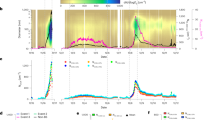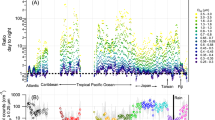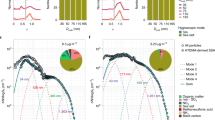Abstract
There has been considerable debate about the relative importance of sea-salt and sulphate from non-sea-salt sources in determining aerosol radiative effects in the marine boundary layer. In the marine boundary layer, the most numerous aerosols are volatile sulphate particles smaller than about 0.08 µm (ref. 1) and most of the aerosol mass is in a few sea-salt particles larger than 1 µm. Yet intermediate-size aerosols between about 0.08 and 1 µm diameter are the most relevant to the radiative forcing of climate because they efficiently scatter solar radiation and also serve as cloud nuclei2. Indeed, Charlson et al.3 hypothesized that oceanic production of sulphate aerosols from the oxidation of dimethyl sulphide could be a powerful feedback in the climate system. It is generally assumed that marine aerosols smaller than about 1 µm are non-sea-salt sulphate, but a recent review cites indirect evidence that many aerosols in the sub-micrometre range contain at least some sea-salt4,5. Here we present direct observational evidence from a remote Southern Ocean region that almost all aerosols larger than 0.13 µm in the marine boundary layer contained sea-salt. These sea-salt aerosols had important radiative effects: they were responsible for the majority of aerosol-scattered light, and comprised a significant fraction of the inferred cloud nuclei.
This is a preview of subscription content, access via your institution
Access options
Subscribe to this journal
Receive 51 print issues and online access
$199.00 per year
only $3.90 per issue
Buy this article
- Purchase on Springer Link
- Instant access to full article PDF
Prices may be subject to local taxes which are calculated during checkout




Similar content being viewed by others
References
Hoppel, W. A., Frick, G. M. & Fitzgerald, J. W. Deducing droplet concentration and supersaturation in marine boundary layer clouds from surface aerosol measurements. J. Geophys. Res. 101, 26553–26565 (1996).
Schwartz, S. E. The whitehouse effect—shortwave radiative forcing of climate by anthropogenic aerosols: an overview. J. Aerosol. Sci. 27, 359–382 (1996).
Charlson, R. J., Lovelock, J. E., Andreae, M. O. & Warren, S. G. Oceanic phytoplankton, atmospheric sulphur, cloud albedo, and climate. Nature 326, 655–661 (1987).
O'Dowd, C. D. & Smith, M. H. Physicochemical properties of aerosols over the Northeast Atlantic: evidence for wind-speed-related submicron sea salt production. J. Geophys. Res. 98, 1137–1149 (1993).
O'Dowd, C. D., Smith, M. H., Consterdine, I. E. & Lowe, J. A. Marine aerosol, sea-salt, and the marine sulfur cycle: a short review. Atmos. Environ. 31, 73–80 (1997).
Pósfai, M., Anderson, J. R., Buseck, P. R. & Sievering, H. Compositional variations of sea-salt-mode aerosol particles from the North Atlantic. J. Geophys. Res. 100, 23063–23074 (1995).
Anderson, J. R., Buseck, P. R. & Patterson, T. L. Characterization ofthe Bermuda tropospheric aerosol by combined individual-particle and bulk-aerosol analysis. Atmos. Environ. 30, 319–338 (1996).
Murphy, D. M. & Thomson, D. S. Chemical composition of single aerosol particles at Idaho Hill: negative ion measurements. J. Geophys. Res. 102, 6353–6368 (1997).
Murphy, D. M., Thomson, D. S., Middlebrook, A. M. & Schein, M. E. In situ single particle characterization at Cape Grim. J. Geophys. Res.ACE-1 special issue (in the press).
McInnes, L. M., Covert, D. S. & Baker, B. The number of sea-salt, sulfate, and carbonaceous particles in the marine atmosphere: TEM measurements consitent with the ambient size distribution. Tellus 49, 300–313 (1997).
Brechtel, F., Kreidenweis, S. & Swan, H. B. Air mass characteristics, total particle concentrations, and size distributions at Macquarie Island, Tasmania during ACE-1. J. Geophys. Res.ACE-1 special issue (in the press).
Kreidenweis, S. M., McInnes, L. M. & Brechtel, F. J. Observations of aerosol composition at Macquarie Island during ACE-1. J. Geophys. Res.ACE-1 special issue (submitted).
Quinn, P. K., Kapustin, V. N., Bates, T. S. & Covert, D. S. Aerosol optical properties in the marine boundary layer during ACE-1 and the underlying chemical and physical aerosol properties. J. Geophys. Res. (in the press).
Hobbs, P. V. Simultaneous airborne measurements of cloud condensation nuclei and sodium-containing particles over the ocean. Q. J. R. Meteorol. Soc. 97, 263–271 (1971).
Blanchard, D. C. The oceanic production rate of cloud nuclei. J. de Rech. Atmos. 4, 1–6 (1969).
Twomey, S. On the composition of cloud nuclei in the northeastern United States. J. de Rech. Atmos. 4, 281–285 (1968).
Huebert, B. J., Zhuang, L., Howell, S., Noone, K. & Noone, B. Sulfate, nitrate, methanesulfonate, chloride, ammonium, and sodium measurements from ship, island, and aircraft during the Atlantic Stratocumulus Transition Experiment/Marine Aerosol Gas Exchange. J. Geophys. Res. 101, 4413–4423 (1996).
Anderson, J. R., Buseck, P. R., Saucy, D. A. & Pacyna, J. M. Characterization of individual fine-fraction particles from the arctic aerosol at Spitsbergen, May–June 1987. Atmos. Environ. 26A, 1747–1762 (1992).
O'Dowd, C. D. et al. Biogenic sulphur emissions and inferred non-sea-salt-sulphate cloud condensation nuclei in and around Antarctica. J. Geophys. Res. 102, 12839–12854 (1997).
Clarke, A. D., Ahlquist, N. C. & Covert, D. S. The Pacific marine aerosol: evidence for natural sulfates. J. Geophys. Res. 92, 4179–4190 (1987).
Rojas, C. M. & Van Grieken, R. Electron microprobe characterization of individual aerosol particles collected by aircraft above the southern bight of the North Sea. Atmos. Environ. 26A, 1231–1237 (1992).
Quinn, P. K., Marshall, S. F., Bates, T. S., Covert, D. S. & Kapustin, V. N. Comparison of measured and calculated aerosol properties relevant to the direct radiative forcing of tropospheric sulfate aerosol on climate. J. Geophys. Res. 100, 8977–8991 (1995).
Quinn, P. K., Bates, T. S., Johnson, J. E., Covert, D. S. & Charlson, R. J. Interactions between sulfur and reduced nitrogen cycles over the central Pacific Ocean. J. Geophys. Res. 95, 16405–16416 (1990).
Tang, I. Thermodynamic and optical properties of mixed-salt aerosols of atmospheric importance. J. Geophys. Res. 102, 1883–1893 (1997).
Fouquart, Y. & Isaka, H. Sulfur emission, CCN, clouds and climate: a review. Ann. Geophys. 10, 462–471 (1992).
Hoppel, W. A., Frick, G. M. & Larson, R. E. Effect of nonrecipitating clouds on the aerosol size distribution in the marine boundary layer. Geophys. Res. Lett. 13, 125–128 (1986).
Bigg, E. K., Gras, J. L. & Evans, C. Origin of Aitken particles in remote regions of the Southern Hemisphere. J. Atmos. Chem. 1, 203–214 (1984).
Ayers, G. P. & Gras, J. L. Seasonal relationship between cloud condensation nuclei and aerosol methanesulphonate in marine air. Nature 353, 834–835 (1991).
Sievering H. et al. Ozone oxidation of sulfur in sea-salt aerosol particles during the Azores Marine Aerosol and Gas Exchange experiment. J. Geophys. Res. 100, 23075–23081 (1995).
Middlebrook, A. M., Murphy, D. M. & Thomson, D. S. Observations of organic material in individual marine particles at Cape Grim during ACE-1. J. Geophys. Res.ACE-1 special issue (in the press).
Acknowledgements
This research is a contribution to the International Global Atmospheric Chemistry (IGAC) Core project of the International Geosphere-Biosphere Programme (IGBP) and is part of the IGAC Aerosol Characterization Experiments (ACE). The assistance of the Cape Grim Baseline Air Pollution Station staff and the Australian Bureau of Meteorology and the Commonwealth Scientific and Industrial Research Organization is acknowledged. Work at Macquarie Island was sponsored by the Office of Naval Research and electron microscope work at Cape Grim was supported by the NSF Atmospheric Chemistry Program. Work aboard the Discoverer was funded by the Aerosols Project of NOAA's Climate and Global Change Program. F.J.B. acknowledges an EPA fellowship and A.M.M. acknowledges a DOE fellowship.
Author information
Authors and Affiliations
Rights and permissions
About this article
Cite this article
Murphy, D., Anderson, J., Quinn, P. et al. Influence of sea-salt on aerosol radiative properties in the Southern Ocean marine boundary layer. Nature 392, 62–65 (1998). https://doi.org/10.1038/32138
Received:
Accepted:
Issue Date:
DOI: https://doi.org/10.1038/32138
This article is cited by
-
Stratospheric ozone depletion in the Antarctic region triggers intense changes in sea salt aerosol geochemistry
Communications Earth & Environment (2023)
-
Sea spray as an obscured source for marine cloud nuclei
Nature Geoscience (2022)
-
Influence of dust and sea-salt sandwich effect on precipitation chemistry over the Western Ghats during summer monsoon
Scientific Reports (2019)
-
Summertime Primary and Secondary Contributions to Southern Ocean Cloud Condensation Nuclei
Scientific Reports (2018)
-
Biogenic hydrogen sulphide emissions and non-sea sulfate aerosols over the Indian Sundarban mangrove forest
Journal of Atmospheric Chemistry (2018)
Comments
By submitting a comment you agree to abide by our Terms and Community Guidelines. If you find something abusive or that does not comply with our terms or guidelines please flag it as inappropriate.



